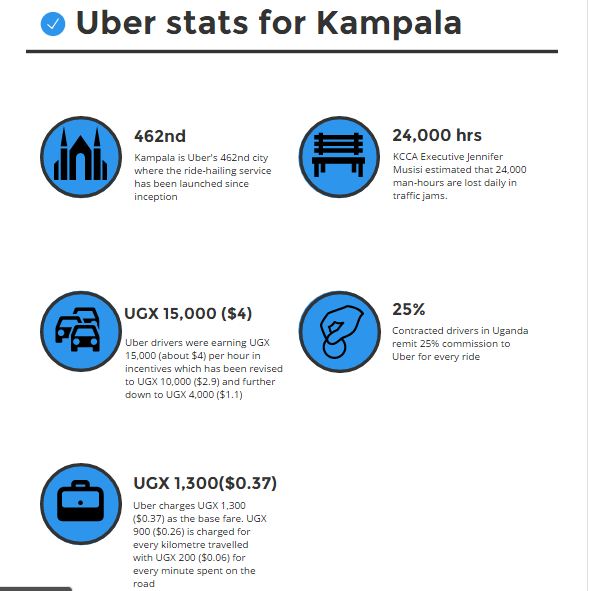Since Uber’s launch, other rival ride-hailing services have followed suit, such as Fone Taxi and Friendship. These joined Uganda’s traditional special hire services, boda bodas (i.e Safe Boda), buses, coasters and the ever present blue-stripped taxis. Unlike places like South Africa and Kenya which saw angry demonstrations against Uber’s entry, the reception by other Ugandan taxi and bus drivers could be interpreted as indifferent at most. Uber charges UGX 1,300 ($0.37) as the base fare. UGX 900 ($0.26) is charged for every kilometre travelled with UGX 200 ($0.06) for every minute spent on the road. Drivers are offered incentives to earn them anywhere between UGX 200,000 ($57) and UGX 350,000 ($100) weekly. This could explain why a good number of people with cars lying about town embraced the service. But according to the EastAfrican, some cracks are starting to appear in the armour. A few disgruntled drivers are leaving Uber having failed to achieve their objective of earning the advertised returns. And here’s why:
Low earnings, high costs
Uber it appears has scaled out the incentives given to its drivers from UGX 15,000 ($4) an hour down to UGX 10,000 and UGX 4,000 ($1). This is a huge contrast with the advertised profits and coupled with a 25% commission to Uber, it’s no wonder that those drivers chose to part ways with the company. Across the border in Kenya, contracted drivers managed to arm-wrestle Uber into reducing their commission rate to 20%. And this was done after Uber reduced the fares by 35% in a bid to offset the competition from the likes of Little (Little Cab). Uganda has no such competition. The drivers on the other hand have to think about KCCA taxes, parking fees, car servicing and maintenance and fuel costs which are not covered by Uber. We are not certain whether Uber has a deal with an ISP to provide internet to its drivers but that is another cost one has to contend with. So at the end of the day, the costs keep mounting and it’s a struggle to break even with the money a driver takes home. Uber can reason that a driver will have to pay for fuel and parking and taxes either way. It comes with the territory. Hundreds of idle cars litter Kampala daily. A sitting car would be considered a liability, if all the owner needs it for is a trip to and fro their areas of residence.
The competition
Special hire taxis differ from Uber in how they do business. The traditional ones do fare estimates based on the driver’s mood, how the passenger looks, rainfall patterns, and time of day. You can also bargain with them which might or might not get you a good price. So in other words, a volatile way of doing business. Airport shuttles are quite expensive, from what we know, so those can’t even compare. The likes of Friendship Taxi do not use apps and one has to call the company (toll free line) and schedule a ride. The prices are higher than what Uber charges and the taxis are branded. Friendship drivers might earn more than Uber at face value, but it’s a full-time job and once you reach a certain ceiling, you won’t be able to earn any more. We have not used Fone Taxi yet so we will reserve this space until we have so that we can share our experience. Buses, coasters and regular taxis are the modus operandi for the average person. The taxis are dirty and cramped. They keep stopping to pick up and offload passengers. They often over-speed too which is not always a good thing.
How drivers earn
Driving for Uber is clearly not a get-rich quick scheme but rather a slow steady process. What Uber has created is an organised system in a place synonymous with transportation chaos. According to Nate Andersen, Uber’s General Manager, their research indicates that most of the vehicles they put to work on the road are in fact underutilised. From making a between 2 or 3 trips a day, they can do 10 to 15 trips which is more money in their pocket. It doesn’t hurt that Uber gets a cut back as well. Surge pricing also works to get more drivers on the road and for a short period of time, they earn abnormal amounts owing to the forces of demand and supply. Considering that traffic has become a serious problem in and around Kampala, Uber drivers actually do make more from it. The more time a passenger spends in an Uber, the more they will be charged, so a driver always earns regardless. You don’t see that with a special hire or a regular taxi.

